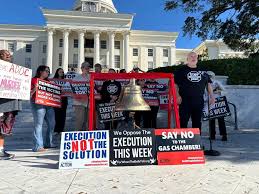Carey Dale Grayson, a 50-year-old man convicted of the 1994 murder of hitchhiker Vickie DeBlieux, was executed Thursday evening at Alabama’s William C. Holman Correctional Facility. Grayson became the third person in the U.S. to be executed using nitrogen gas, a controversial method introduced earlier this year.
Grayson was sentenced to death for his role in the brutal murder of DeBlieux, who was hitchhiking from Tennessee to Louisiana when she accepted a ride from Grayson and three other teens. Prosecutors said the group took her to a wooded area, beat her, and later mutilated her body, which was found at the bottom of a cliff near Odenville, Alabama. Grayson was the only one of the group sentenced to death, as the other teens were under 18 at the time of the crime.
Execution Details
The execution began shortly after 6 p.m. Grayson, strapped to a gurney and wearing a gas mask, made obscene gestures and used profanity before the nitrogen gas was administered. Witnesses reported that Grayson shook, gasped, and struggled against the restraints as the execution progressed. Alabama Corrections Commissioner John Q. Hamm stated the nitrogen flowed for 15 minutes, and Grayson was declared dead at 6:33 p.m.
This marked Alabama’s third execution using nitrogen gas, a method that replaces breathable air with pure nitrogen, causing death by oxygen deprivation. Critics have raised concerns over the method, pointing to visible signs of distress in the three individuals executed so far. Grayson’s lawyers argued that nitrogen hypoxia causes “conscious suffocation” and fails to deliver the swift unconsciousness promised by the state.
Victim’s Family Reacts
Vickie DeBlieux’s daughter, Jodi Haley, who was 12 at the time of her mother’s murder, expressed complex emotions following the execution. Speaking to reporters, Haley described her mother as “unique, spontaneous, and gorgeous.” She also criticized the execution, saying, “Murdering inmates under the guise of justice needs to stop. No one should have the right to take a person’s possibilities, days, and life.”
Haley acknowledged Grayson’s troubled upbringing, noting that he suffered severe abuse as a child. “Society failed this man as a child, and my family suffered because of it,” she added.
Governor and Officials Respond
Alabama Governor Kay Ivey issued a statement after the execution, calling Grayson’s crimes “heinous” and emphasizing that the method used bore no comparison to the brutality of DeBlieux’s murder.
Hamm addressed concerns about the execution process, stating that some of Grayson’s movements appeared to be voluntary and intended to create a scene, while others were involuntary reactions expected during nitrogen gas executions.
Background on Nitrogen Gas Executions
Alabama remains the only state to have carried out executions using nitrogen hypoxia. The method was authorized in 2018, alongside Oklahoma and Mississippi. Supporters claim it offers a more humane alternative to lethal injection, though critics argue it lacks sufficient testing and transparency.
Grayson’s execution occurred hours after the U.S. Supreme Court rejected his appeal for a stay, which sought further review of the nitrogen gas method.
A Tragic Legacy
Grayson’s execution closes a chapter on a crime that shocked Alabama nearly 30 years ago, but it has reignited debate over the ethics and efficacy of nitrogen gas as a means of execution. As Haley reflected, “While justice has been served, it does not undo the loss of my mother or the suffering caused by these events.
- Central Texas Faces Rising Demand for Senior Services Amid Population Growth - November 24, 2024
- 30-Year Sentence for Austin Driver in Fatal Leander Collision - November 24, 2024
- Exclusive Sneak Peek at Austin City Limits’ Historic 50th Anniversary Episode - November 24, 2024
